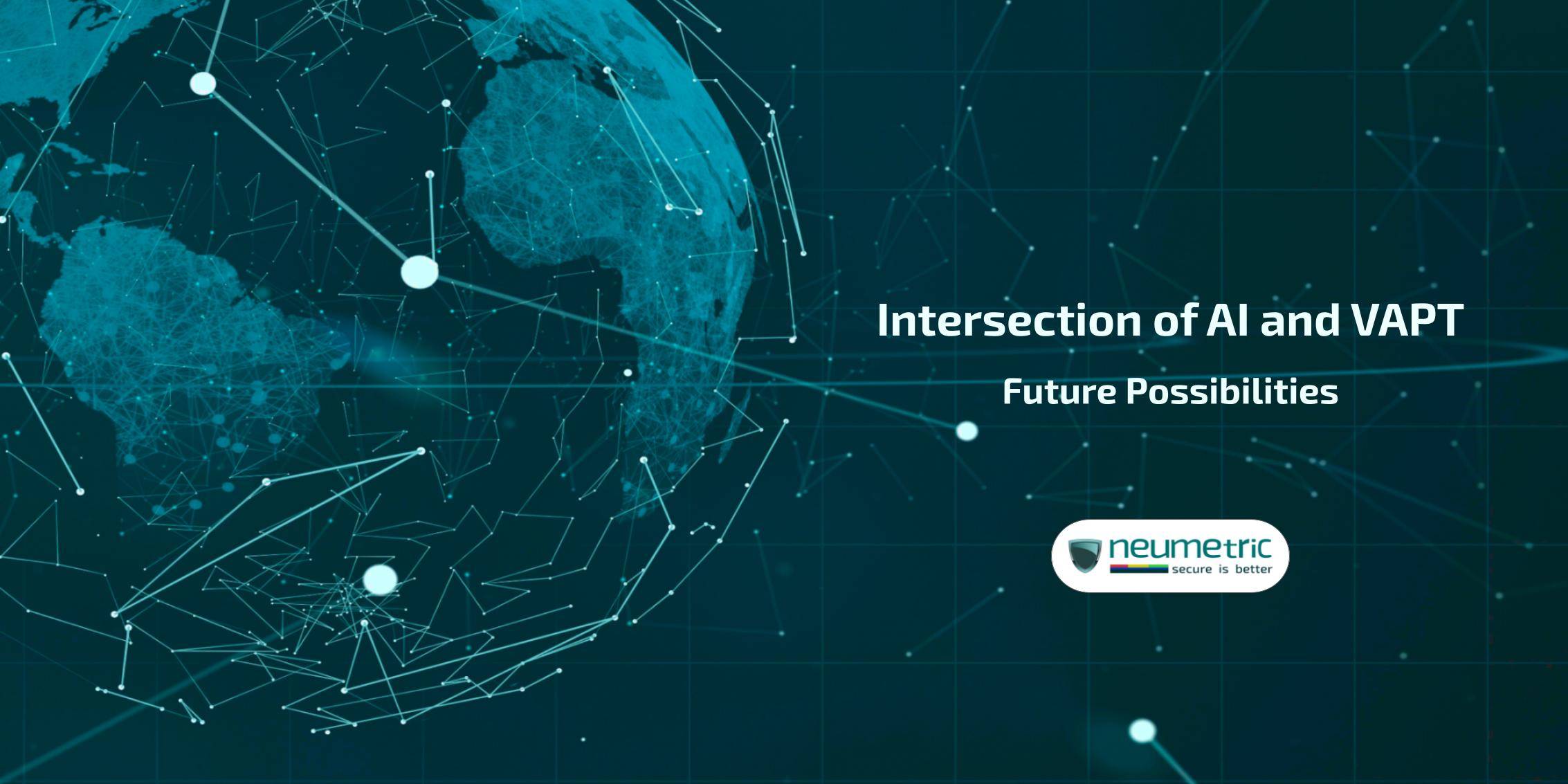Table of Contents
ToggleIntroduction
At the forefront of contemporary cybersecurity are Artificial Intelligence [AI] & Vulnerability Assessment & Penetration Testing [VAPT]. Artificial Intelligence [AI], which is the machine simulation of human intelligence, has transformed a number of industries & is now essential to cybersecurity procedures. VAPT, on the other hand, combines penetration testing & assessment into a comprehensive approach to finding & fixing vulnerabilities in a system. The combination of AI & VAPT has become a game-changer in cybersecurity in recent years. While VAPT offers a methodical approach for locating vulnerabilities & bolstering digital defences, AI offers unmatched capabilities for automation, pattern recognition & analysis.
The convergence of AI & VAPT is extremely significant because it elevates cybersecurity procedures to a new degree of sophistication. The continually changing threat landscape frequently makes it difficult for traditional approaches of vulnerability assessment & penetration testing to stay up to date. AI adds a dynamic component that makes it possible for cybersecurity experts to identify & address attacks instantly. Because AI algorithms are predictive, possible weaknesses can be found before malevolent actors take use of them. By taking a proactive stance, organisations can improve their entire security posture & narrow the window of opportunity for assaults.
Understanding VAPT
Vulnerability Assessment & Penetration Testing [VAPT] is a comprehensive approach to identifying & addressing security vulnerabilities in computer systems, networks & applications. The primary goal is to assess the security posture of an organization by identifying weaknesses that could be exploited by malicious entities.
VAPT encompasses two main components:
- Vulnerability Assessment [VA]: The methodical process of finding, measuring & ranking vulnerabilities in a system is known as vulnerability assessment. It’s a preventative step used to identify any vulnerabilities that an attacker might exploit.
Components are as follows:
Scoping & Asset Identification: Specify what will be assessed & which assets—hardware, software & network components—will be examined.
Inventory of Assets: Make a thorough inventory of every asset & classify it according to importance & relevance to the activities of the company.
Vulnerability Scanning: To find known vulnerabilities in systems & networks, use automated technologies. This covers incorrect setups, lax security procedures & software flaws.
Risk Prioritisation: Prioritise risks by assessing vulnerabilities according to their seriousness, possible consequences & chance of exploitation. Set cleanup efforts in order of priority.
- Penetration Testing [PT]: A controlled simulation of actual cyberattacks to find & exploit weaknesses in a controlled environment, penetration testing is also known as ethical hacking. The objective is to evaluate security measures’ efficacy & ascertain the likelihood of unauthorised access or data breaches.
Components are as follows:
Organising & Observation: Establish the objectives & parameters of the penetration test, collect data & comprehend the target environment.
Threat Modelling: Taking into account both internal & external elements, identify potential risks & attack vectors relevant to the organisation.
Exploitation: Make a concerted effort to exploit vulnerabilities that have been found in order to evaluate the efficacy of security controls & confirm the seriousness of the vulnerabilities.
Post-Exploitation Analysis: Evaluate the consequences of successful exploitation, assess the risk of a breach & provide insights into potential avenues for improvement.
Reporting: Document findings, including vulnerabilities exploited, the impact of successful attacks & recommendations for remediation. The report serves as a roadmap for strengthening security measures.
The Rise of Artificial Intelligence
Artificial Intelligence [AI] refers to a set of technologies that are intended to imitate human-like intelligence in robots. These technologies use algorithms, data & computational power to accomplish jobs that were previously performed by humans. Narrow AI, General AI & Superintelligent AI are the three primary types of AI. Narrow AI, also known as Weak AI, is the most common type, built to accomplish narrow tasks while lacking general cognitive capacities.
The use of AI into cybersecurity has ushered in a new age. AI technologies provide a level of sophistication & efficiency that is critical in dealing with the continually changing threat scenario. In contrast to traditional cybersecurity approaches, AI functions in real time, allowing organisations to detect, analyse & respond to threats at unprecedented speeds.
AI enhances cybersecurity by providing advanced capabilities in threat detection, pattern recognition & anomaly analysis. Machine learning algorithms, a subset of AI, can learn from historical data to identify patterns indicative of potential security incidents. This adaptability is particularly valuable in an era where cyber threats are becoming more complex & adaptive.
The combination of Artificial Intelligence [AI] & Vulnerability Assessment & Penetration Testing [VAPT] ushers in a paradigm shift in how organisations approach cybersecurity. The capabilities of AI are being used to streamline & strengthen the vulnerability assessment & penetration testing procedures.
AI technologies aid in the more efficient & accurate detection of potential vulnerabilities in vulnerability assessments. AI-powered automated scanning solutions can quickly analyse massive volumes of data to identify vulnerabilities in software, networks & configurations. This speeds up the evaluation process & enables organisations to fix vulnerabilities in near real time.
The Interplay: AI & VAPT
A. Integration of AI in Vulnerability Assessment
Automated Scanning & Identification: AI-powered automated scanning systems excel at fast discovering vulnerabilities in a variety of IT landscapes. Machine learning algorithms are used in these programmes to recognise patterns linked with known vulnerabilities, decreasing the manual effort necessary for thorough scans. This not only expedites the evaluation step, but also ensures a more thorough examination of the digital environment.
Predictive Analysis for Vulnerability Prioritisation: AI incorporates predictive analytics into vulnerability assessment, allowing organisations to prioritise remediation activities based on vulnerability impact. AI algorithms assist organisations in focusing on high-priority vulnerabilities first by analysing previous data & assessing the risk of exploitation. This proactive strategy aligns with the goal of reducing attackers’ window of opportunity.
B. AI in Penetration Testing
Dynamic & Adaptive assault Simulations: AI supports dynamic & adaptive assault simulations in penetration testing. Traditional penetration testing are frequently static & lack the agility needed to simulate developing cyber threats. AI alters this by allowing simulations to adapt in real-time to match the methods of sophisticated adversaries. This dynamic approach assesses an organization’s readiness to respond to constantly changing threat scenarios in a more realistic manner.
Machine Learning-Driven vulnerability Discovery: In penetration testing, machine learning is used to improve vulnerability discovery. AI algorithms can analyse system behaviours & discover potential vulnerabilities that traditional methods may find difficult to spot. Machine learning models grow adept at recognising novel attack routes by learning from previous exploitation scenarios, providing more robust & adaptive penetration.
The interplay between AI & VAPT represents a synergistic alliance that empowers organizations to proactively manage & mitigate cybersecurity risks. As we explore the future possibilities in the next sections, it becomes evident that this integration is laying the foundation for a more resilient & responsive cybersecurity landscape.
Future Possibilities
Advanced Threat Detection: AI-driven anomaly detection, a novel way to identify threats, holds the key to the future of cybersecurity. Traditional security systems frequently rely on rule-based procedures, which struggle to adapt to cyber enemies’ ever-changing tactics. Machine learning techniques are used in AI-driven anomaly detection to build baselines of typical behaviour & detect anomalies that may indicate malicious activities. This advanced threat detection mechanism allows organizations to identify subtle, sophisticated threats that might go unnoticed by conventional security measures. By continuously learning from data patterns, AI systems can recognize anomalies in real-time, providing a proactive defense against emerging threats.
Proactive Defense Mechanisms: The use of AI into threat prediction is poised to change the way businesses anticipate & mitigate cyber threats. AI systems with large datasets & advanced algorithms can analyse historical attack data to forecast future threats. AI-powered threat prediction allows organisations to keep one step ahead of prospective adversaries by recognising patterns & correlating disparate types of data. Proactive threat prediction not only improves response times but also aids in the prevention of vulnerabilities. It enables cybersecurity professionals to strengthen defences in advance of specific threats, lowering overall risk exposure.
Continuous Learning & Adaptation: As cyber threats become increasingly sophisticated, AI systems’ ability to learn & adapt is critical. Machine learning algorithms included in cybersecurity frameworks are always evolving to detect & counter new threats. These systems provide a dynamic defence mechanism against hackers’ ever-changing methods by analysing new attack patterns & modifying their models accordingly. Continuous improvement is built into the future of AI-powered VAPT. Creating feedback loops that integrate insights from real-world situations aids in the refinement & improvement of AI systems. These loops allow the system to learn from its achievements & failures, enabling an improvement cycle that improves the overall cybersecurity posture.
Ethical Considerations
Potential Pitfalls & Biases in AI-Powered VAPT: While using AI into VAPT provides numerous benefits, it also raises ethical concerns. AI systems may unwittingly perpetuate biases contained in the data on which they were trained if not properly built & managed. Furthermore, the possibility of false positives & false negatives in threat detection might have unexpected repercussions, negatively hurting persons or organisations.
Ensuring Transparency & Accountability: Transparency & accountability are essential for addressing ethical problems in AI-driven VAPT processes. Organisations must be open about their use of AI, the data sources that feed the algorithms & the decision-making processes. Putting in place accountability procedures guarantees that human oversight is maintained & that AI system decisions can be understood, explained, and, if required, corrected.
Striking the Right Balance: Human Expertise & AI Capabilities: As AI plays an increasingly integral role in cybersecurity, it is crucial to strike the right balance between automation & human expertise. While AI excels in processing vast amounts of data & identifying patterns, human intuition & ethical judgment remain irreplaceable. Cybersecurity professionals must collaborate with AI systems, leveraging the strengths of both to create a resilient defense strategy.
Challenges & Limitations
Data Privacy Concerns
A major issue at the convergence of AI & VAPT is the increased concern for data privacy. Because AI systems rely significantly on large datasets for training & analysis, sensitive data handling poses considerable hazards. The data obtained during vulnerability assessments & penetration tests in the context of VAPT may include sensitive information about an organization’s infrastructure.
Organisations must use strong data anonymization & encryption methods to meet these problems. Compliance with privacy rules & a privacy-by-design strategy are critical first steps. The importance of ethical data management grows, emphasising the need for open communication with stakeholders regarding the sorts of data collected & the objectives for which it will be used.
Adversary Attacks on AI-Powered Systems
AI-powered VAPT is vulnerable to adversarial assaults, which are purposeful attempts to influence or deceive AI systems. Adversaries may exploit AI algorithm vulnerabilities by feeding it harmful data in order to fool the system into producing inaccurate predictions or classifications. This adds the danger of attackers altering vulnerability assessment results or evading detection during penetration tests in the context of VAPT.
Continuous monitoring & upgrading of AI models is required to counter adversarial attacks. Adversarial training, in which AI models are exposed to potential assault scenarios during training, helps to improve their resilience. Furthermore, organisations should include human oversight to detect & respond to hostile attempts that automated systems alone may not discover.
Conclusion
The convergence of AI & VAPT constitutes a watershed moment in cybersecurity advancement. When AI technologies are integrated into vulnerability assessment & penetration testing, security measures improve in terms of speed, accuracy & adaptability. The combination of AI-driven automation & human skill enables a potent defence against cyber threats that are both dynamic & smart.
In the future, the revolutionary potential of AI-driven VAPT is enormous. The capacity to forecast & proactively defend against emerging threats, combined with continuous learning mechanisms, allows organisations to more successfully navigate the complicated cybersecurity landscape. The future promises a proactive, adaptable & highly efficient defence approach that advances in tandem with the ever-changing threat scenario.
A proactive approach to tackling issues is vital as organisations embrace the promise of AI-driven VAPT. Concerns about data privacy should be addressed through strong privacy safeguards, openness & ethical data processing procedures. To counter sophisticated manipulation attempts, adversarial attacks demand continual awareness & the insertion of human oversight. To avoid overreliance, the cybersecurity arsenal must strike the appropriate balance, recognising the merits of both AI & human skill.
The intersection of AI & VAPT is not without challenges, but it is through addressing these challenges that the true potential of this synergy can be realized. A collective call to action for organizations & cybersecurity professionals is crucial to ensuring the responsible & effective integration of AI in securing digital landscapes. By navigating these challenges with diligence & strategic planning, the future of cybersecurity can be shaped into a more resilient & proactive defense ecosystem.
FAQ’s
- How does AI contribute to vulnerability assessment?
AI in vulnerability assessment automates scanning processes, rapidly identifying potential weaknesses in software, networks & configurations through advanced algorithms & pattern recognition.
- What role does AI play in penetration testing?
In penetration testing, AI enables dynamic & adaptive attack simulations, mimicking real-world cyber threats & utilizes machine learning for the discovery of novel exploits, enhancing the overall effectiveness of testing.
- What are the future possibilities of AI-driven VAPT?
Future possibilities include advanced threat detection using AI-powered anomaly detection, proactive defense mechanisms with AI-driven threat prediction & continuous learning & adaptation through machine learning for evolving threats.





